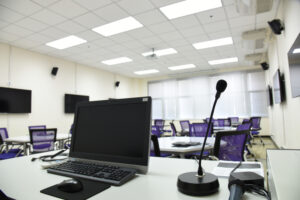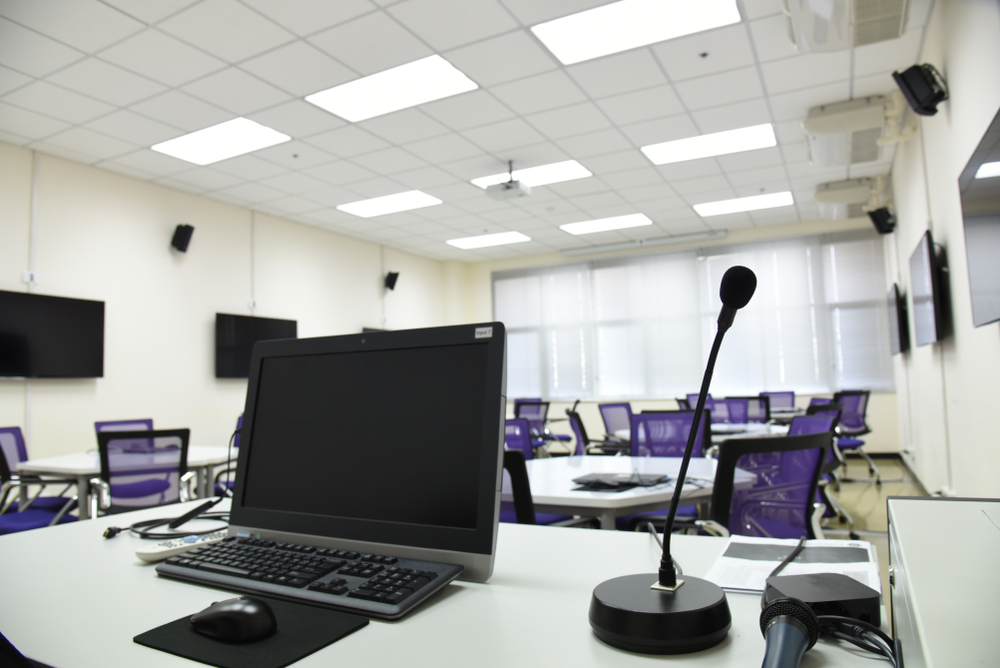The classroom environment has changed significantly over the past couple of decades, thanks to the continued adoption of audio-visual equipment in schools and educational technology tools. What began as the occasional use of legacy analogue devices like overhead projectors and TV carts has rapidly transformed into the widespread deployment of digital AV solutions specifically designed to facilitate and enhance teaching practices in the modern classroom. From interactive touch screens to classroom control systems supporting multiple inputs and bringing any device to life in stunning clarity and size, these AV innovations are helping inspire students while making lessons more engaging, efficient, and impactful.

The Rise of Digital in the Classroom
A key advancement driving much of this AV evolution has been the replacement of antiquated overhead projectors with ultra-bright, high-resolution digital projectors. Originally adopted mainly in halls and auditoriums for events and assemblies, schools soon realised the enormous benefits of permanently installing ceiling-mounted projectors connected to networked computers in general classrooms as well. This allowed teachers to easily project media and online content as part of interactive presentations and activities. The huge projection size helped ensure all students had unobstructed views of onscreen content—a major improvement over cramped positions crowding around outdated tube monitors. Powerful built-in speaker systems also delivered clear, intelligible audio to make presentations more immersive. Students were enthralled by the cinematic scale, dynamically interacting directly with vibrant digital presentations from the teacher’s desktop perched on a modern motorised projector lift for accessible storage when not in use.
The digital projection boom kicked into overdrive once interactive whiteboards arrived, revolutionising hands-on, whole-class teaching. Suddenly, the lesson content shown on the giant projected screens was augmented by touch control functions, continuing lessons at a dynamic and fast pace. Annotating slides, highlighting text, moving images around, and even importing online content during a lesson gave teachers immense flexibility. The technology allows them to react and adjust lessons spontaneously based on responses and interaction from students as lessons unfold. More participation builds further engagement, keeping pupils focused and attentive as they directly interact with the touch boards alongside teachers during lessons. These projector-based systems shifted educational approaches to more visual, practical styles ideal for varied learning strengths.
More recently, adoption of flat-panel touch-screen displays known as Interactive Flat Panels (IFPs) has soared thanks to their multi-capability versatility. Mounted to walls like large TVs, IFPs combine touch screens with built-in computers, customised AV control software, integrated speakers, and optional ports. This gives teachers supreme flexibility to run sophisticated lesson content like educational apps, presentation slides, sound, video, and web platforms while mirroring other networked devices—all controlled intuitively via touch and pen. Some models feature up to 20 touch points allowing groups of students to get hands-on simultaneously. Schools are realising that migrating from bulky projectors to sleeker flat panels saves space while boosting learning and collaboration. Power over Ethernet (PoE+) network cabling even eliminates projector power cables and lift boxes simplifying installation in classrooms.
Networked AV and Unified Communications
Another key driver transforming teaching practices has been the adoption of AV over IP systems, where network projectors, speakers, and other devices then route signals, controls, and power using simplified structured cable infrastructure. Centralised AV routing matrices streamline the consolidation of a variety of media sources like document cameras, computers, tablets, playback sources, and wireless sharing platforms that teachers now utilise daily in technologically rich environments. Using intuitive control interfaces like customisable touch screens or IP access via mobile devices, teachers can walk into rooms and instantly activate, switch, and combine equipment reliably from convenient locations. Streamlined, consistent operation frees them to focus on lesson delivery rather than troubleshooting connections or displaying content. Networking AV also enables innovative IP-based classroom communication solutions, supporting teaching and learning models centered around discussion, collaboration, and the sharing of ideas. Ceiling microphone arrays for voice reinforcement ensures teachers can be clearly understood throughout rooms regardless of their volume or body positioning relative to students. Video conferencing platforms allows classrooms to connect with outside experts or partner with other schools on joint projects and peer evaluations. These unified communications solutions, managed through user-friendly control systems, amplify teaching practices far beyond what non-networked equipment can accomplish.
Improved Inclusivity
For students and teachers with auditory, visual or mobility impairments, today’s AV systems increase accessibility to improve inclusiveness. Voice amplification makes teachers clearly understood. Projected captions, signing and annotation can aid hearing-impaired pupils. Screen readers allow blind students to better follow presentations through headphones. Input tools like assistive pointing devices or sip and puff switches help those lacking dexterity to fully operate equipment independently alongside classmates. Control apps even allow students to manage gear from their own mobile devices. Thoughtful AV design ensures those needing accommodations can actively participate and succeed.
Production studios with cameras, vision mixers, and chroma key systems encourage televised school newscasts and content creation. Theatre-style auditoriums boasting cinema-quality projections, surround sound and mood lighting set stages inspiring creativity. Video walls in hallways and lobbies enable live broadcast of assemblies and events within buildings or even across district campuses. Outside, massive outdoor displays turn playgrounds and sports pitches into jumbo scoreboards with animated graphics amplifying the school spirit.
Sophisticated AV systems generate invaluable usage and performance analytics, providing data that drives smarter decisions on optimising educational investments long-term. Cloud-based device management generates helpful scheduled maintenance alerts to prevent issues through timely component replacement before failures occur. Asset tracking confirms inventory while pinpointing misplaced equipment. Usage metrics highlight adoption patterns, helping administrators gauge what solutions teachers utilise in real-world practice day-to-day vs one-off novelty gadgets. This empirical data quantifies success in directing future purchases and staff development priorities.
Teaching Transformed
The tremendous teaching transformations and measurable learning improvements brought on by rapid AV advancements prove educators readily embrace technology when it provides authentic benefits enhancing productivity and student outcomes. The journey continues as schools explore emerging innovations like augmented and virtual reality platforms, 3D printing labs, coding robots, and AI tutors, allowing students to acquire future-focused skills. Savvy integration of audiovisual technology promises to further revolutionise teaching and learning for years to come.



